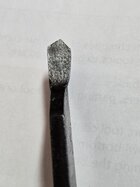-
July 2025 Turning Challenge: Turn a Multi-axis Weed Pot! (click here for details) -
Congratulations to James Seyfried for "NE Red Oak II" being selected as Turning of the Week for July 21, 2025 (click here for details) -
Welcome new registering member. Your username must be your real First and Last name (for example: John Doe). "Screen names" and "handles" are not allowed and your registration will be deleted if you don't use your real name. Also, do not use all caps nor all lower case.
You are using an out of date browser. It may not display this or other websites correctly.
You should upgrade or use an alternative browser.
You should upgrade or use an alternative browser.
Mcnaughton coring blades
- Thread starter Peter D'Attomo
- Start date
Mine look more centered than that, but I don't think it is a problem. The main reason for the diamond tip is for coring burl. The idea is to have the v groove create a more controlled break out at the end rather than tear a hole in your work.
All the tips should have that shape. Because of flex in the blade they tend to drift a little towards the outside of the bowl. The theory of grinding the tip like that is to help push the blade in the opposite direction to reduce the drift.
Thank you all. my mystery is redolved
Well, going back many years to when the blades had the cutting edge all on the outside of the bar, I had heard that people were experimenting with different nose profiles, so I did also. I tried bevel to the left, bevel to the right, and bevel square. It made no difference to the tracking abilities of the blade, and I mean absolutely zero. If you look at the blades and/or put them on one of the big plastic circle templates, the very tip of the blade goes straight rather than following the perfect arc of a circle. Best guess is that the blades are profiled, as in the top and bottom outside is rounded over on a belt sander before they are bent. Ask anyone who does metal bending, and there is no way to get enough pressure on the tip to get it to bend to that perfect arc. If they want to bend the perfect arc, then they bend several inches longer than the needed length, and snip off the straight part. This would make it difficult to profile the top and bottom of the blade. Because the last inch or two of the blade goes straight rather than following the perfect arc, the blade will always drift to the outside of the cut. The only other way to do it would be to take a torch to it and heat it up, then bend it to final shape. I would think that the metal cutting surface (you NEVER sharpen the top of the blade because the cutter is so thin) would come off/delaminate. The spear point is a Mike Mahoney idea. He does 'fishtail' as he cores, meaning he sweeps back and forth a bit to open up the kerf. I still prefer a square cutting edge. If the entire blade was a perfect arc, it would be a lot easier to core with.
I do have a video up on You Tube about using the McNaughton, Dale Bonnertz does too. Not sure if Mike Mahoney's video is up there or not.
robo hippy
I do have a video up on You Tube about using the McNaughton, Dale Bonnertz does too. Not sure if Mike Mahoney's video is up there or not.
robo hippy
Not sure if Mike Mahoney's video is up there or not.
robo hippy
I just stumbled across Mike's video on his You tube channel 3 days ago. Having never seen it, I was glad to see it. All 3 are worth watching, if only for the different approaches and manners of teaching/demonstrating.
Thank you all
I was quite disappointed when I purchased a new set of blades. The grinding was crude and uneven. The blades had bandsaw marks and numerous burrs. None of the edges were sanded or rounded. The blades would not slide through the new gate. It took me consider time correcting the thes major manufacturers flaws.

